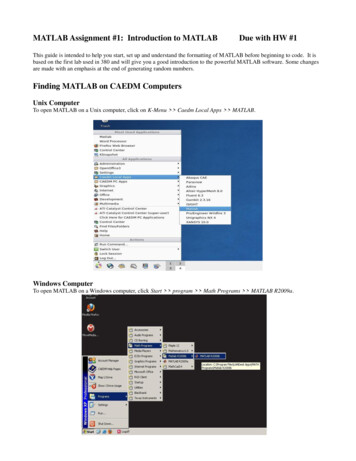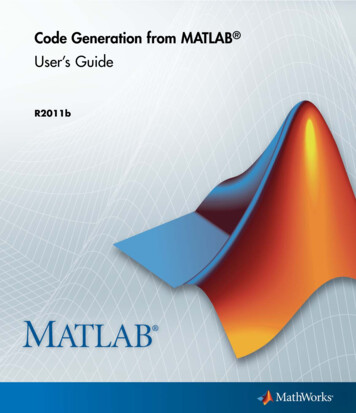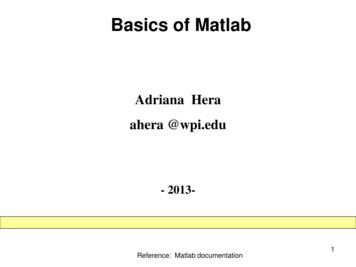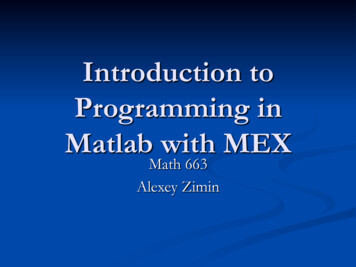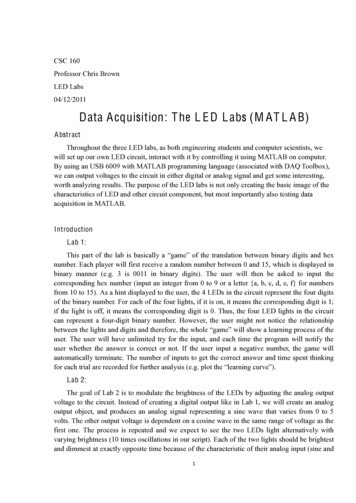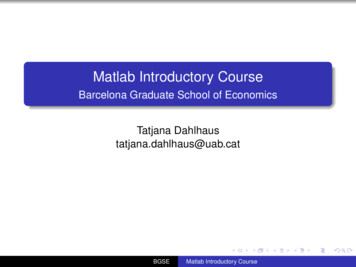
Transcription
Matlab Introductory CourseBarcelona Graduate School of EconomicsTatjana Dahlhaustatjana.dahlhaus@uab.catBGSEMatlab Introductory Course
Course OutlineThe course is designed assuming no knowledge of theprogram. The main reference is Winistörfer, P. and Canova, F.(2008), "Introduction to Matlab".1The Command Window2Matrix Construction and Manipulation3Data Importing and Exporting4Mathematical Functions5Random Numbers6Graphics7Scripts and Functions8Controlling the Flow (if, for, do-while)Evaluation: Final homeworkBGSEMatlab Introductory Course
1. The Command Window1. The Command WindowBGSEMatlab Introductory Course
1. The Command WindowWhen you open Matlab the command window is createdand made the active window.It is the interface which with we communicate with Matlab.The prompt (») indicates that Matlab is ready to obtaininstructions.From now on we will denote Matlab code as typesetletters.Command can be executed by pressing the ENTER key.Typing the command clear x deletes the value ofvariable x .clear deletes all values that have been created during aMatlab session.Matlab is case sensitiv.BGSEMatlab Introductory Course
1. The Command WindowIf you type » X Matlab does the following1234It verifies if X is a variable in the Matlab workspace.If not, it verifies if X is a built-in-function.If not, it verifies if a m-file named X.m exists in the currentdirectory.If not, it verifies if X.m is anywhere on the Matlab searchpathIf Matlab cannot find X.m anywhere an error message willappear.A Matlab search path can be added or removed byselecting Set Path in the file menu.A semicolon (;) at the end of the line tells Matlab not todisplay the results from the executed command.Text following ’%’ is considered as comment and is notexecuted.We can press the Up-arrow key to recall previouscommand lines.BGSEMatlab Introductory Course
1.2 The Help FacilityThe help facility provides information about Matlabfunctions, commands and symbols.The command »help returns a list of directories thatcontain Matlab related files.Typing »help topic displays the help about this topic ifit exists.help elmatprovides information on elementary matricesand matrix manipulation.BGSEMatlab Introductory Course
2. Matrix Construction and Manipulation2. Matrix Construction andManipulationBGSEMatlab Introductory Course
2.1 Building a MatrixDefining a vector:rowvector: » V [1 2 3 4]columnvector: » V [1; 2; 3; 4]Defining a matrix:» B [1 2 3 4; 5 6 7 8]B is a 2 4 matrix, i.e., 1 2 3 4B 5 6 7 8Defining a 3D matrix:» A(:,:,1) B» A(:,:,2) [9 10 11 12; 13 14 15 16]A is 2 4 2 matrix.BGSEMatlab Introductory Course
2.1 Building a MatrixThere are some special matrices which are extremely useful:The zero matrix: zeros(m,n) creates a m n matrix ofzeros.» B zeros(2,3)results in 0 0 0B 0 0 0The ones matrix: ones(m,n) creates a m n matrix ofones.» B ones(2,3)results in 1 1 1B 1 1 1BGSEMatlab Introductory Course
2.1 Building a MatrixThe identity matrix: eye(n) creates a n n matrix withones along the diagonal and zeros everywhere else.» B eye(3)results in 1 0 0B 0 1 0 0 0 1The colon notation is a shortcut for producing rowvectors.a:b:c produces a vector of entries starting with the value a,incrementing by the value b until it gets to c.» V 1:4results in V 1 2 3 4» V 0.32:0.1:0.6results in V 0.32 0.42 0.52BGSEMatlab Introductory Course
2.2 Accessing a MatrixYou can access the element at the ith row and the jthcolumn by typing B(i,j)Accessing ith row B(i,:)Accessing jth column B(:,j)Accessing ith to (i c)th row and jth to (j n)th columnB(i:i c,j:j n)Accessing last row and last column B(end,end)diag(B)extracts diagonal elements of a matrix.tril(B)creates lower triangular matrix.triu(B)creates upper triangular matrix.BGSEMatlab Introductory Course
2.2 Accessing a MatrixLinear indexing: B(n)Accesses the nth element if counting columnwisefind(B c)finds linear index of values of B which are bigger than c.B(find(B c))access values of B which are bigger than c.logical expressions:& ’and’, ’or’, ’equal’, ’not equal’ ’smaller or equal’, ’strictly less’, ’bigger or equal’, ’strictly bigger’BGSEMatlab Introductory Course
2.2 Accessing a MatrixConsider matrix 1 2 3B 5 6 7 9 4 8 » F B(1:2,2:3)yields 2 3F 6 7» F B(2:end,[1 3])yields 5 7F 9 8BGSEMatlab Introductory Course
2.2 Accessing a MatrixConsider matrix 1B 59264 37 8» a B(4)yields a 2» F find(B 4)yields 2 3 F 5 8 9» F B(find(B 4))yields 5 9 F 6 7 8BGSEMatlab Introductory Course
Exercises12Write a 50 1 vector of 5s. (Don t write it manually)Write the following rowvector (1 2 . 30 30 . 2 1).3Define » A [-1 2 -3; 4 5 -6] and set all positiveelements to 1 and all the negative ones to 0.4Given matrix A from the previous point set all the negativeelements in the first row to zero.5Given matrix A from the previous point set all the negativeelements and all elements bigger or equal than 5 to zero.6Given matrix A from the previous point set all elementslying between 2 and 5 to zero.7Type » A 0. What‘s the difference to » find(A 0) ?BGSEMatlab Introductory Course
Exercises: Solutions12» ones(50,1)*5» [1:30 (-30:-1)*-1]» [1:30 30:-1:1]3» A(A 0) 0» A(A 0) 14» A(1,find(A(1,:) 0)) 05» A(find(A 0 A 5)) 06» A(find(A 2&A 5)) 07It does not produce an index but a logical vector in which 1stand for ’true’ and 0 stands for ’false’.BGSEMatlab Introductory Course
2.3 Matrix Operations (Vectoralisation)Making Vectors from Matrices and Reverse:Define 1 2B 5 6 9 4The vectoralisation of B can be obtained by »A B(:) 1 5 9 A 2 6 4Suppose we have A and want to get B. This can be done bytyping» reshape(A,3,2)BGSEMatlab Introductory Course
2.3 Matrix Operations (Transpose)Transpose of a Matrix:Define 1 2B 5 6 9 4The Transpose of B can be obtained by »A B’ and yields 1 5 9A 2 6 4BGSEMatlab Introductory Course
2.3 Matrix Operations (Basic Operators)Addition: Substraction: Multiplication: Right Division: / (B/A BA 1 )Left Division: \ (A \ B A 1 B)Exponentiation:ˆ (Aˆ(2) A2 )Array Operations (element-by-element): To indicate anarray operation the standard operator is preceded by a dot,i.e., .* ./ .ˆ» x [1 2 3]» y [4 5 6]» x.*yans 4 10 18BGSEMatlab Introductory Course
2.4 Built-in Functionssort(A): sorts the elements in ascending order. If A is amatrix, sort(A)treats the columns of A as vectorsreturning sorted columns.size(A)returns the size of matrix A.[m,n] size(A)returns the size of matrix A in variables mand n.» A [1 2; 3 4; 5 6]» [m,n] size(A)yieldsm 3n 2BGSEMatlab Introductory Course
2.4 Built-in Functionssum(A)returns the sum of elements if a A is a vector. If Ais a matrix, sum(A)returns a rowvector of the sums ofeach column.» A [1 2; 3 4; 5 6]» C sum(A)yieldsC 9 12cumsum(A)returns the cumulative sum. If A is a matrix, itreturns a matrix of the same size as A containing sums foreach column.» C cumsum(A)yieldsC 1 24 69 12BGSEMatlab Introductory Course
2.4 Built-in Functionsmin(A) (max(A))returns a row vector containing theminimum (maximum) element of each column if A is amatrix.mean(A)returns a row vector containing the mean of theelements of each column.median(A)returns a row vector containing the median ofthe elements of each column.std(A)returns a row vector containing the standarddeviation of each column.inv(A)returns the inverse of a square matrix.»A [3 2; 1 4]»B inv(A)yields 0.4000 0.2000B 0.1000 0.3000BGSEMatlab Introductory Course
2.4 Built-in Functions[P,D] eig(A)returns a matrix of eigenvectors (P) andeigenvalues (D) of a quadratic matrix.» A [0.95 0.05; 0.25 0.7]» [P,D] eig(A)yields 0.7604 0.1684P 0.6495 0.9857 0.99270D 00.6573kron(A,B)produces the Kronecker product of A and BBGSEMatlab Introductory Course
Exercises12From the matrix 1 2 3A 4 5 6 7 8 9 obtain the columnvector ′a 1 2 3 4 5 6 7 8 9 . Multiply a 1 2 3 and b 2 4 6 in such a way toobtain c 2 4 18 .BGSEMatlab Introductory Course
Exercises1reshape(A’,9,1)2c a.*bBGSEMatlab Introductory Course
3. Data Importing and Exporting3. Data Importing and ExportingBGSEMatlab Introductory Course
3.1 Exporting Data FilesBefore starting we have to indicate the correct current directoryin the command toolbar. As an exercise we will create 4different data files.Clear the workspace.Define»x [1:1:50]’»y [0.1:0.1:5]’Create the Matlab data file result1.mat» save result1The two vectors are saved in the file result1.mat.Create another Matlab file result2.mat» save result2 yThe vector y is saved in the file result2.matBGSEMatlab Introductory Course
3.1 Exporting Data FilesCreate another Matlab file result3.txt» save result3 y -asciiThe vector y is saved in the 8-digit ASCII text format in thefile result3.txtCreate another Matlab file result4.dat» save result4.dat xThe vector x is saved in the file result4.txtBGSEMatlab Introductory Course
3.2 Importing Data FilesNow we will import the 4 datafiles we previously saved.Clear the workspace.Import data file result1.mat» load result1The two vectors y and x are imported in the workspace.clear workspace againImport data file result2.mat» load result2The vector y is imported in the workspace.BGSEMatlab Introductory Course
3.2 Importing Data FilesClear the workspace again.Import data file result3.txt» load result3The vector called result3 is imported in the workspace.clear workspace againImport data file result4.dat» a importdata(’result4.dat’)The vector a is imported in the workspace.BGSEMatlab Introductory Course
3.3 Importing Data from ExcelMatlab can also read data from .xls files directly (no needto transform everything into ASCII format).data xlsread(filename, sheet)reads the specified worksheet, where sheet is either apositive, double scalar value or a quoted string containingthe sheet name.data xlsread(filename, ’range’)reads data from a specific rectangular region of the defaultworksheet (Sheet1). Specify range using the syntax’C1:C2’, where C1 and C2 are two opposing corners thatdefine the region to be read. For example, ’D2:H4’represents the 3-by-5 rectangular region between the twocorners D2 and H4 on the worksheet. The range input isnot case sensitive and uses Excel A1 notation.BGSEMatlab Introductory Course
3.3 Importing Data from Exceldata xlsread(filename, sheet, ’range’)reads data from a specific rectangular region (range) of theworksheet specified by sheet.Example.xls contains data on GDP (column B),Consumption (column C), Investment (column D), Exports(column E) and Imports (column F). To read these 5 timesseries into Matlab type» data xlsread(’Example.xls’, ’NationalAccount’,’B4:F205’)BGSEMatlab Introductory Course
4. Mathematical Functions4. Mathematical FunctionsBGSEMatlab Introductory Course
4.1 Rounding NumbersMathematical function are applied on an element-by-elementbasis.There are several ways of rounding and chopping realnumbers to give integers.Define » x pi*(-1:3)x (-3.1416 0 3.1416 6.2832 9.4248)round(x) rounds the elements of x to the nearestintegers.fix(x) rounds the elements of x to the nearest integerstowards zero.floor(x) rounds the elements of x to the nearestintegers towards minus infinity.ceil(x) rounds the elements of x to the nearest integerstowards infinity.sign(x) is the Signum function. For each element of x,sign(x) returns 1 if the element is greater than zero, 0 ifit equals zero and -1 if it is less than zero.BGSEMatlab Introductory Course
4.2 Trigonometric Functionssin(x) gives the Sine.sinh(x) gives the Hyperbolic Sine.cos(x) gives the Cosine.cosh(x) gives the Hyperbolic Cosine.tan(x) gives the Tangent.tanh(x) gives the Hyperbolic Cosine.sec(x) gives the Secant.sech(x) gives the Hyperbolic Secant.BGSEMatlab Introductory Course
4.3 Exponential Functionsexp(x) is the exponential, i.e., ex .log(x) is the natural logarithm.log10(x) is the common logarithm.sqrt(x) is the square root.BGSEMatlab Introductory Course
4.4 Complex functionsabs(x) is the absolute value.angle(x) is the phase angle.conj(x) is the complex conjugate.imag(x) is the complex imaginary part.real(x) is the complex complex real part.BGSEMatlab Introductory Course
5. Random Numbers5. Random NumbersBGSEMatlab Introductory Course
5. Random NumbersMatlab has a number of functions which allow to draw randomnumbers.rand(m,n) produces m n matrix containingpseudorandom values drawn from the standard uniformdistribution on the open interval(0,1).To generate values from the uniform distribution on theinterval [a, b] user a (b-a).*rand(m,n)randn(m,n) returns an m n matrix containingpseudorandom values drawn from the standard normaldistribution.To generate values from a normal distribution with mean µand standard deviation σ.r µ σ.*randn(m,n)BGSEMatlab Introductory Course
5. Random Numbersbetarnd(A,B,m,n) returns a m n matrix of randomnumbers chosen from the beta distribution with parametersA and B.chi2rnd(V,m,n) returns a m n matrix of randomnumbers chosen from the chi-square distribution with Vdegrees of freedom.exprnd(MU,m,n) returns an m n matrix containingrandom numbers chosen from the exponential distributionwith location parameter MU.gamrnd(A,B,m,n) returns an m n matrix of randomnumbers chosen from the gamma distribution with shapeparameter A and scale parameter B.lognrnd(MU,SIGMA,m,n) returns an m n matrix ofrandom numbers generated from the lognormal distributionwith parameters MU and SIGMA.trnd(V,m,n) returns an m n matrix of of randomnumbers chosen from Student’s t distribution with VMatlab Introductory Coursedegrees of freedom. BGSE
Exercises log e4 /2.2π1Compute2Write a command that will simulate the n throws of a pair ofdice.3Given a 20 2 matrix of iid N(1,2) random vectors, buildthe corresponding demeaned values.4Build two N 1 vectors k and y where each entry of y isyt 3 0.5X1t 0.9X2t ǫt where Xit is Normal(i, 2) andǫt is Normal(0, 1) and kt 3 0.5X1t 0.9X2t Using thestandard OLS formula estimate the coefficients, 1 X11 X21 . for′ 1′i.e.,β̂ (X X ) X y where X . 1 X1NN 50, 1000, 5000. What do you observe?BGSEMatlab Introductory Course
Exercises: Solutions123» (sqrt(log(exp(4)))/2)/(2*pi)» floor(1 6*rand(n,2))» rv 1 2*randn(10,2)» Demeaned rv-ones(10,1)*mean(rv)BGSEMatlab Introductory Course
Exercises: SolutionsSince for y data was simulated with an error term, we expectthe betas to be around 3, 0.5 and 0.9, respectively. Theestimates will get closer as N increases. Since for k wesimulated the data without an error term, the betas will beexactly 3, 0.5 and 0.9, respectively, independently of N.» N 50;» X1 1 2*randn(N,1);» X2 2 2*randn(N,1);» Y 3 0.5*X1 0.9*X2 randn(N,1);» K 3 0.5*X1 0.9*X2;» X [ones(N,1) X1 X2];» Betay inv(X’*X)*X’*Y;» Betak inv(X’*X)*X’*K;Define N 1000, N 5000, and redo the commands.BGSEMatlab Introductory Course
6. Graphics6. GraphicsBGSEMatlab Introductory Course
6.1 HistogramOne important command when dealing with graphics is clfwhich clears the graphic screen. Graphs can be editedmanually by opening the plot tools.hist(x) draws a 10-bin histogram of the vector x. If Y isa matrix, hist works down the columns.hist(x,m) draws a m-bin histogram of the vector x.hist(x,c) draws a histogram of the vector x using thebins specified in c.»»»»x 9)BGSEMatlab Introductory Course
6.2 Plotting Series versus their Indexplot(x) plots the data in x against versus its indexplot([x y]) plots the data of x and y versus their indexin the same graph. Therefore, if the input is a matrix plotplots the data of each column versus their index.»»»»x randn(50,1);plot(x)plot([x randn(50,1)])plot([x randn(50,1) randn(50,1)])BGSEMatlab Introductory Course
6.3 2D-Scatterplotplot(x,y,S) is the general form of a scatterplotx and y are vectors and S is string specifying colour,marker symbol or line redgreenbluewhiteblackSymbol.ox otteddashdotdashedload ,5),’cx’)BGSEMatlab Introductory Course
6.3 2-D Scatterplotplot(x,y,S,x,z,S) plots two scatterplots in one.» ,4),’b ’)Adding titles and labels »plot(data(:,5),data(:,3),’b.’)» title(’Scatterplot of Credit CardExpentiture vs. Age’)» xlabel(’Credit Card Expenditure’)» ylabel(’Age’)BGSEMatlab Introductory Course
6.4 More 2-D Plotting Commandsloglog produces a log-log scale plot.semilogx produces a semi-log scale plot in which thex-axis has a log scale.semilogy produces a semi-log scale plot in which they-axis has a log scale.polar produces a polar coordinate plot.» t (y) draws the columns of the M N matrix y as Mgroups of N vertical bars.» bar(rand(10,5),’stacked’), colormap(cool)» bar(rand(5),’grouped’)fplot(f,lim) plots the function f between the x-axislimits specified by lim [xmin xmax].» fplot(@(x) [sin(x) cos(x)], 2*pi*[-1 1])BGSEMatlab Introductory Course
6.5 3-D Line Plotsplot3 is a three-dimensional analogue of plot .plot3(x,y,z,S) , where x, y and z are three vectors ofthe same length, plots a line in 3-space through the pointswhose coordinates are the elements of x, y and z.plot3(X,Y,Z) , where X , Y and Z are three matrices ofthe same size, plots several lines obtained from thecolumns of X , Y and Z .Example:» t 0:pi/50:10*pi;» plot3(sin(t),cos(t),t)BGSEMatlab Introductory Course
6.6 Surface PlotsThe first step in displaying a function of variablesz f (x, y ) is to generate a grid on the domain of thisfunction.Matlab then evaluates and graphs this functions using thisgrid.[X,Y] meshgrid(x,y) transforms the domainspecified by vectors x and y into matrices X and Y (grid).surf(X,Y,Z) plots the colored parametric surfacedefined by X , Y and Z .mesh(X,Y,Z) plots the colored parametric mesh definedby X , Y and Z .BGSEMatlab Introductory Course
6.6 Surface Plots22For example, to evaluate the function x exp x y over therange 2 x 2, 2 y 2,» [X,Y] meshgrid(-2:.2:2, -2:.2:2);» Z X .* exp(-X.ˆ 2 - Y.ˆ 2);» surf(X,Y,Z)» mesh(X,Y,Z)contour3(X,Y,Z) produces a 3-D contours plot.zlabel creates a label for the z-axis.BGSEMatlab Introductory Course
6.7 Subplotssubplot(m,n,p) breaks the Figure window into an m-by-nmatrix of subplots and selects the p-th subplot for the currentplot.» subplot(2,2,1), contour3(peaks)» subplot(2,2,2), mesh(peaks)» subplot(2,2,3), surf(peaks)» subplot(2,2,4), surfl(peaks)where peaks is a function of two variables, obtained bytranslating and scaling Gaussian distributions.BGSEMatlab Introductory Course
7. Scripts and Functions7. Scripts and FunctionsBGSEMatlab Introductory Course
7. Scripts and FunctionsIn the command-driven mode Matlab (when we entersingle-line commands) Matlab processes the commandsimmediately.Matlab can also execute a sequence of commands that arestored in .m files.There are two types of .m files: Scripts and Functions.Scripts .m files are used to execute a long list ofcommands.Functions allow us to create new functions in addition tothe built-in-functions of Matlab that solve user-specificproblems.BGSEMatlab Introductory Course
7.1 ScriptsWhen a scripts is invoked Matlab simply execute thecommands found in that .m file.Statements in a script file can operate on the data in theworkspace or create new data to the workspace.To create a script, choose File - New - m-file.A text editor window is opened in which you can type thesequence of commands.To save a script, choose File - Save.You can execute the script by typing the filename in thecommand window or press the "Run" button (white squarewith green triangle).Make sure that Matlab can find your script file in thecurrent directory or in the path.BGSEMatlab Introductory Course
7.1 ScriptsExample: Type the following sequence in the editor window.A [1 2 3; 4 5 6; 7 8 9];B [7 8 9; 6 5 4; 3 1 2];S A B;P A*B;DP A.*B;K kron(A,B);BGSEMatlab Introductory Course
7.2 FunctionsA .m file that comtains the word "function" in the first line ofthe file is a function file.You can pass arguments into the function.Variables defined and manipulated inside the file are localto the function and cannot be accessed globally in theworkspace.The general syntax for defining a function isfunction [ output1, output2, .] name(input1, input2, .)% inlcude here the text for the helpstatementThe name of the function and the .m file (the name underwhich you save it) should be the same.The remainder of the functions is a sequence ofcommands producing the output variables.BGSEMatlab Introductory Course
7.2 FunctionsExample: Define a function which calculates the mean ofmatrices.function average mymean(X)% Calculate mean value of a matrix X% average is a row vector containing the meanof each column.m size(X,1);average sum(X)/m;This new function can be used like any other Matlab function.Type in the command window. » B [10:10:100;5:5:50]’;»mymean(B)ans 55.0000 27.5000BGSEMatlab Introductory Course
7.2 Exercises1Plot y sin 3πx using fplot and plot for 0 x 1.2Write a function that calculate the Standard Deviation of amatrix.3Write a function that will simulate N throws of 2 dice andreturns the mean of the throws.4Build a N 1 vector y where each entry of y isyt a bX1t cX2t ǫt where Xit is Normal(i, 2) and ǫt isNormal(0, 1). Write a function which calculates OLSestimates for β of the model y having as inputs N, a, b andc.BGSEMatlab Introductory Course
7.2 Exercises (Solutions)1» fplot(@(x) sin(3*pi*x), [0 1])»N 100; h 1/N; x 0:h:1»y sin(3*pi*x);»plot(x,y)2function a mystd(data)% calculates the standard deviation of amatrix.m size(data,1);a function m throws(n)% Simulates n throws of a pair of dice andreturns the mean.sim floor(1 6*rand(n,2));m mean(sim);BGSEMatlab Introductory Course
Exercises: Solutions4.function Beta OLSSimulation(N,a,b,c)% returns OLS estimates from simulated dataregression.X1 1 2*randn(N,1);X2 2 2*randn(N,1);Y a b*X1 c*X2 randn(N,1);X [ones(N,1) X1 X2];Beta inv(X’*X)*X’*Y;BGSEMatlab Introductory Course
8. Controlling the Flow8. Controlling the FlowBGSEMatlab Introductory Course
8.1 The FOR LoopMost often FOR loops are used when a set of statementsis to be repeated a fixed, predetermined number of times n.The FOR loop takes the formfor variable expressionstatements;endwhere expression is a row vector of the length n, that isprocessed element-by-element (usually we use the rowvector 1:1:n). statements stands for a sequence ofstatements to the program.Example:for i 1:1:10x(i) i;endThe loop assigns values 1 to 10 to the first 10 elements ofx.BGSEMatlab Introductory Course
8.1 The FOR LoopExample (nested FOR loop):for i 1:1:10for j 1:1:10A(i,j) 1/(i j-1);endendBGSEMatlab Introductory Course
8.2 The WHILE LoopThe WHILE loop allows a set of statements to be repeatedan indefinite number of times, under the control of some orone logical conditions.The general form of a WHILE loop iswhile conditionstatements;endWhile the conditions are satisfied the statment will beexecuted.Example:a 1;while a 10a a 1;endaBGSEMatlab Introductory Course
8.3 The IF StatementThe IF statement execute a set of statements if a conditionis satisfied.Its general form isif condition1%commands if condition1 is truestatement1;elseif condition2% commands if condition2 is truestatement2;else% commands if condition1 and condition2are falsestatment3;endBGSEMatlab Introductory Course
8.3 The IF StatementExample: x -1 2*rand(100,1);for i 1:1:100if x(i) 0d(i) 1;elseif x(i) 0d(i) -1;elsed(i) 0;endendBGSEMatlab Introductory Course
Exercises123456Using a FOR loop write a script that collects 10 randomnumbers from the uniform(0,1) in a column vector. Can youdo the same thing using "vectorization"?Replicate the first twenty numbers of the Fibonacci series:1 2 3 5 8 13 21 34 55 89 144. Hint: for i 3,xi xi 1 xi 2P. Tc, where T 20, C 10, r 0.05. AlsoCompute a t 1 (1 r)tdo it by vectorization.Write a function which adds two matrices (1. Check ifmatrices are comformable, 2. If yes, add the correspondingelements).What is the greatest value of n that can be used to in thesum 12 22 . n2 to get a value of less than 100?Generate a series of returns (i.e. randn(100,1)) usind FORand IF implement the following trading signal. Buy if theReturn is bigger than the average of the past 5 years.(Build a series "Buy" that takes on value 0 if we don t buyBGSEMatlab Introductory Courseand 1 if we buy.)
Exercises1. for i 1:1:10R(1,:) rand;endR rand(10,1);2.S [1 2];for i 3:1:20S(i) S(i-1) S(i-2);end3.for t 1:1:20a(t) 10/(1 0.05)ˆ t;endsum(a);C 10*ones(1,20);R (1 0.05).ˆ[1:20];sum(C./R);BGSEMatlab Introductory Course
Exercises4.function c add(a,b)% c add(a,b). This is the function which adds% the matrices a and b. It duplicates% the MATLAB function a b.[m,n] size(a);[k,l] size(b);if m k n l,r ’ERROR using add: matrices are not thesame size’;endc zeros(m,n);for i 1:mfor j 1:nc(i,j) a(i,j) b(i,j);endendBGSEMatlab Introductory Course
Exercises5.S 1; n 1;while S (n 1)2 100n n 1;S S n2 ;end»[n,S]BGSEMatlab Introductory Course
Exercises6.R randn(100,1);for t 1:size(R,1)if t 5if R(t) mean(R(t-5:t))Buy(t) 1;elseBuy(t) 0;endendendBGSEMatlab Introductory Course
3.2 Importing Data Files Now we will import the 4 datafiles we previously saved. Clear the workspace. Import data file result1.mat » load result1 The two vectors y and x are imported in the workspace. clear workspace again Import data file result2.mat » load result2 The vector y is imported in the wo


